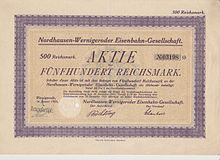Nordhausen-Wernigeroder Railway Company
The Nordhausen-Wernigerode Railway Company (NWE) was after the Gernroder-Harzgerode Railway in the second resin founded railways .
history
On June 15, 1896, the NWE was founded by the United Railway Construction and Operating Company in Berlin, which also carried out operations. The first section of the narrow-gauge Harzquerbahn was opened as early as 1896 and the Brockenbahn , which was also narrow-gauge , was opened in 1898 . On April 1, 1908, the NWE took over management of the United Railway Construction and Operating Company.
In Eisfelder Talmühle there was a transition to the Gernrode-Harzgeroder Eisenbahn-Gesellschaft (GHE) and in the Sorge station there was a transition to the Südharz-Eisenbahn-Gesellschaft (SHE). In the Nordhausen and Wernigerode stations, there was a connection to the standard-gauge trains of the Prussian State Railways , later the Deutsche Reichsbahn . In Drei-Annen-Hohne there was a connection to the Halberstadt-Blankenburg railway . By 1925 the NWE had around 250 employees plus around 100 seasonal workers. From 1926 the NWE also operated its own bus routes (called: "Harzer Roller" ). The workshop and administration were in Wernigerode.
After the Second World War , the NWE was responsible for the remainder of the GHE, the railway line Eisfelder Talmühle - Stiege - Hasselfelde as well as the remainder of the SHE Sorge - Tanne in the course of the dismantling of the GHE systems and machines from April 15, 1946 . The NWE was later expropriated on the basis of a referendum and in 1948 was part of the Saxony-Anhalt state railways.
The Harzquer- and Selketalbahn were operated by the Deutsche Reichsbahn from 1949 . Harzer Schmalspurbahnen GmbH has been the owner and operator of the Harzquer, Brocken and Selketalbahn since 1993 .
Traction vehicles
| No. | DR number | design type | Construction year | annotation |
|---|---|---|---|---|
| 1 to 3 | 99 5803 and 5804 | B n2t | 1896 | |
| 6 and 7 | 99 6101 and 6102 | C h2t | 1914 | Hot / wet steam locomotive |
| 11 to 22 | 99 5901 to 5905 | B'B n4vt | 1897-1901 | In 1914 seven copies were handed over to the Heeresfeldbahn, in 1918 renumbered to nos. 11 to 17, in 1927 renumbered again to nos. 11 to 15 II |
| 21 II | 99 6001 | 1'C1 'h2t | 1939 | corresponds to the new type range for meter-gauge locomotives developed by Krupp shortly before the outbreak of the Second World War |
| 31 and 32 | - | C'C n4vt | 1909 | Sold in 1921 |
| 41 and 42 | - | 1'D1 'h2t | 1913 | Sold in 1914/18 |
| 41 II | 99 5906 | B'B n4vt | 1918 | Bought in 1920 |
| 51 and 52 | 99 6011 and 6012 | (1'B) B1 'h4vt | 1922/23 | |
| 61 | - | B n2t | 1899 | Standard gauge locomotive, for works connections in Nordhausen, bought in 1925, † 1934 |
| 61 II | 98 6213 | B n2t | 1908 | Standard gauge locomotive, bought in 1934 for works connections in Nordhausen |
| 71 and 72 | 99 5631 and 5632 | C1 'n2t | 1890 | Formerly Chemins de fer départementaux de la Côte-d'Or , taken over in 1946 |
| T 1 to 3 | VT 137 561, VT 137 565, VT 137 566 (later 187 025) | Bo'Bo ' | 1939 | Combustion railcars |
Lore
The records of the Nordhausen-Wernigeroder Railway Company are in the Dessau department of the Saxony-Anhalt State Archives .
literature
- Gerhard Zieglgänsberger, Hans Röper: The Harz Narrow Gauge Railways : The Selketalbahn; The Harzquer and Brocken Railway; The southern resin railway. transpress Verlag, Stuttgart 1999, ISBN 3-613-71103-6
- Jörg Bauer: 100 years of Harzquer and Brocken Railway. EK-Verlag GmbH, Freiburg 1999, ISBN 3-88255-685-4
Individual evidence
Web links
- NWE share ( Memento from July 19, 2011 in the Internet Archive )
- Early documents and newspaper articles on the Nordhausen-Wernigeroder Railway Company in the 20th Century press kit of the ZBW - Leibniz Information Center for Economics .
- Tradition of the Nordhausen-Wernigeroder railway company in the holdings of the Reichsbahndirektion Magdeburg in the state archive of Saxony-Anhalt, Dessau department


